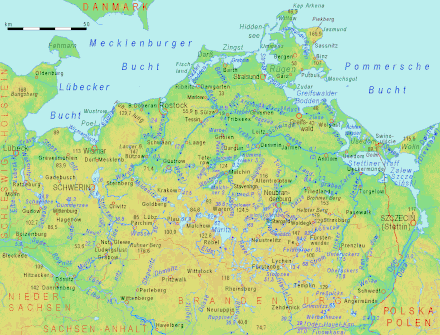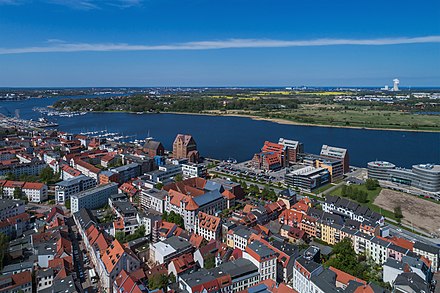Mecklenburg-Western Pomerania (Mecklenburg-Vorpommern) is a Land (state) in Germany, located in the northeastern corner of the country between Brandenburg, Schleswig-Holstein, Lower Saxony and the Baltic Sea, and the neighboring country of Poland. The name is sometimes abbreviated in German to Meck-Pomm (think Mc-Pom), though locals of the state are unlikely to use the name, but you will be understood.
It is the least populated part of Germany and thus offers vast natural reserves. Historically, Pomerania continues to the east following the Baltic coastline of Poland. The inland of Mecklenburg-Western Pomerania is relatively flat, as is most of northern Germany, though there are various glacial hills and valleys. There are a large number of lakes formed by glaciers during the last Ice Age. Mecklenburg and Pomerania are known for their many historical Baltic seaside resorts with noble architecture and fine sandy beaches, that are unmatched in most of Europe. The region also offers many hidden castles and manor houses, well-kept medieval towns and an intact nature.

Cities


- Rostock 📍 - The largest city, a hanseatic city close to the sea , with medieval buildings in the city center, a seaside resort (Warnemünde, its port) and the oldest university in the Baltic region
- Schwerin 📍 - State capital of Mecklenburg-Western Pomerania
- Stralsund 📍 - A well-preserved medieval city center of world cultural heritage value, another former member of the hanseatic league
- Greifswald 📍 - university town, also a former member of the hanseatic league
- Wismar 📍 - A well-preserved medieval city center of world cultural heritage value
- Neubrandenburg 📍 - urban center of the Mecklenburg Lake District, Lake Tollensesee, medieval wall and Brick Gothic gates, famous concert church
- Bad Doberan 📍
- Sassnitz 📍 - on the island of Rügen, major fishing port with the longest outside mole of Europe, chalk-cliffs north of the town ("Königstuhl" = "King's Chair")
- Peenemünde 📍 - on the island of Usedom, during World War II this was the site of Nazi weapon research (V1, V2)
- Binz 📍 - Famous seaside resort on the island of Rügen, holiday resort with very long sandy beach.
- Kühlungsborn 📍
- Güstrow 📍
- Heringsdorf 📍
- Hiddensee
Other destinations
- Baltic Sea Coast - features picturesque beaches and steep, dramatic chalk cliffs in some locations
- Rügen - Germany´s largest island in the Baltic just off the coast, location of many seaside resorts and scenic sea cliffs, great bathing beaches
- Usedom - nice island in the east of Mecklenburg-Western Pomerania
- Fischland-Darß-Zingst - peninsula with fine sand beaches and unspoiled nature
- Müritz - Germany´s largest lake on its territory, with a national park on its eastern shore
- "Vorpommersche Boddenlandschaft" - ("Western Pomeranian Lagoons") National Park on the coast between Rostock and Rügen
- Jasmund National Park - national park on Rügen
Understand
Mecklenburg (originally pronounced with a long "e") Vorpommern is the least densely populated German state, but has been a major (domestic) tourist destination as early as the 19th century. As some of Germany's (historically) most important Baltic ports are here, its cities were among the preeminent in the Hanseatic League (though it was de facto led by Lübeck just across the state border to the west), as well as a desired prize for all Baltic powers. As such pieces of it belonged to Sweden for a long time, starting with the thirty years war (1618-1648) and later Prussia acquired the eastern parts.
Trade and shipbuilding have always been important for coastal cities like Rostock and its port Warnemünde and the GDR heavily depended upon its Baltic seacoast both for tourism and other economic activities such as fishery and ship-building. After the fall of the GDR the crisis hit this area particularly hard, as the shipyards could not deal with the new competition (mostly from Korea) and East Germans eager to explore their new-found freedom of travel stopped vacationing in the seaside resorts. However, starting in the mid 1990s tourism has bounced back, as even Western Germans have discovered the allure of the Baltic Sea and many East Germans returned to the vacation spot of their youth. While the shipyards still haven't quite turned the corner they have now specialized in (higher prized) military and specialist vessels, where the high wages don't hurt them as much.
Another promising field are renewable energies, as the coast is very windy and the entire state is rather flat, making it the ideal site for windmills and their production. Tourism is still mostly geared towards Germans and (to a lesser degree) their neighbors to the east, particularly Poland. As this was the main beach destination in GDR times FKK (Freikörperkultur, that is naturism or nude bathing) is the norm rather than the exception.
Talk
In the larger cities (especially Rostock) you can get around well with English. Elsewhere, only younger people regularly understand English, so learning a few basic German phrases can be helpful. You may have some luck with Russian among people who grew up during GDR times, as it was compulsory in GDR schools. That said, many people have forgotten all but basic Russian, due to lack of practice. Mecklenburg and Pomerania are home to many German dialects of Low German still spoken in rural areas. Low German is a language spoken in northern Germany and is closely related to Dutch (and some words are even similar to English). All Low German speakers speak Standard German, too.
Get in
By plane
Rostock airport (Laage, IATA: RLG) has few international flights, so the best choices are usually Berlin Brandenburg Airport or Hamburg Airport.
By train
Trains from Hamburg and Berlin to the major cities (Rostock, Schwerin, Stralsund) leave every 1-2 hours. There are also regular train connections from Poland (Szczecin).
By boat
From Denmark (Gedser) there are frequent ferry connections to Rostock. Trelleborg in Sweden has several departures a day to Rostock and Sassnitz on Rügen. There are also ferry lines from several Eastern Baltic ports, primarily to Rostock.
By car
The fast motorway network (Autobahn) has been considerably extended during the last years and all larger cities now have excellent connections. In the summer months, especially on weekends, the motorways and all roads to the coast can be congested.
By bus
While they are a comparatively new phenomenon, Intercity buses in Germany serve most major and some minor towns throughout the country with prices often surprisingly low to compete with the better comfort and journey time of trains.
Get around
The train network is well developed and even smaller towns have regular connections. Take some time though - a 50km ride can take an hour or more, which is considerably longer than elsewhere in Germany. In rural areas, traveling by car is the most comfortable way to get around. The quality of the roads is generally very good. Locals often drive aggressively, disrespecting speed limits and passing recklessly.
A very interesting way to get around is by bicycle. There are special touristic bikeways along the Baltic coast and from Berlin to Rostock. Most regular roads also make attractive bike routes. Main roads often have separate bicycle lanes beside them. If they don't, keep off - riding there is both dangerous and unpleasant!
See

- The Hanseatic cities on the Baltic coast, namely Wismar, Stralsund, Rostock and Greifswald are well worth a visit. The old towns of Wismar and Stralsund are even listed as World Heritage sites.
- Jasmund National Park with the 118 m chalk cliff "Königstuhl" ("Kings chair") on the island of Rügen
- the 5 km long KdF-building complex and ruins in Prora on the east coast of Rügen (KdF = "Kraft durch Freude" => "Strength through Joy" – the Nazi era popular recreation concept): Not pretty, but impressive
- the Kap Arkona (Cape Arkona) on the north coast of Rügen
- the beautiful sea bridges (seebrücke - or "piers" in UK English) of some coastal towns (e.g. Sellin / Rügen and Ahlbeck / Usedom)
- Dobbertin Abbey was founded in 1220. South of Güstrow
Do
This is mostly a beach destination, so swimming is the main activity of most visitors. It is also a good area for hiking. Mecklenburg Lake District is a prime destination for canoeing or a houseboat vacation, but also for cycling.
Eat
- fish in all variations ("Rollmops", "Bismarckhering"...)
Drink
- beer from the local breweries in Rostock, Stralsund and Lübz
- Glashäger mineral-water
- Sand-thorn juice
Stay safe
Go next
- Mecklenburg-Western Pomerania is bordered by the German states of Schleswig-Holstein, Lower Saxony and Brandenburg, and the Polish region of Zachodniopomorskie.
- Cruising the Baltic Sea